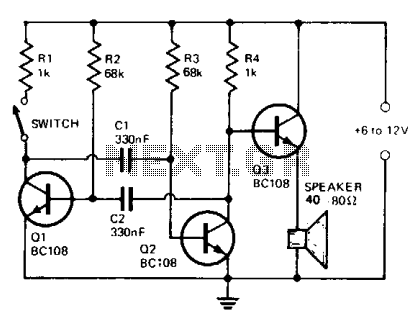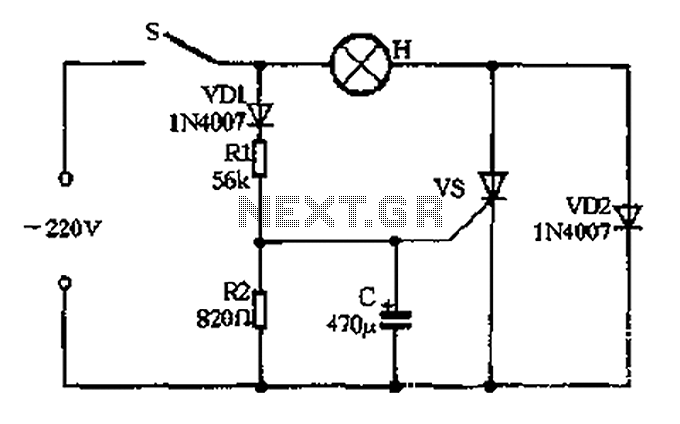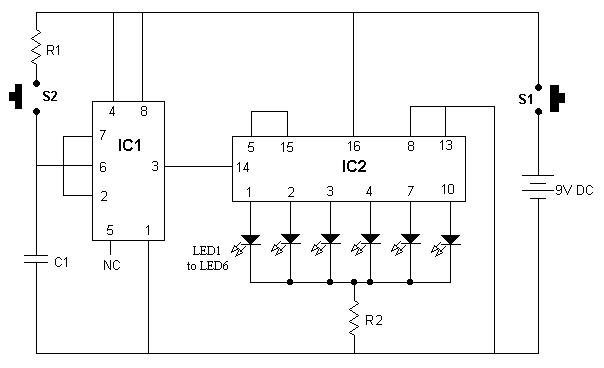
Electronic ship siren

The circuit comprises a multivibrator (Q1 and Q2) and a low-power output stage (Q3). The speaker should have an impedance ranging from 40 to 80 ohms. To accommodate a low-impedance speaker, an output transformer should be connected from the emitter of Q3 to ground. Capacitors C1 and C2 set the pitch of the siren, with specified values producing a tone of approximately 300 Hz. The quiescent current is minimal. Additionally, the output at the collector of Q2 can be routed to an amplifier input through a 1 µF electrolytic capacitor in series with a 12 kΩ resistor.
The circuit functions as a tone generator, utilizing a multivibrator configuration formed by transistors Q1 and Q2, which operate in a feedback loop to produce oscillations. The frequency of oscillation, and thus the tone produced by the siren, is determined by the values of capacitors C1 and C2, which create a timing interval that governs the charge and discharge cycles of the capacitors. The output from the collector of Q2 is a square wave signal that can be utilized to drive a speaker directly or through an output transformer, depending on the speaker's impedance.
For speakers with an impedance lower than the specified range, the output transformer serves to match the impedance, ensuring efficient power transfer and preventing damage to the circuit components. The low-power output stage Q3 amplifies the signal from the multivibrator, providing sufficient power to drive the speaker without excessive energy consumption.
The electrolytic capacitor (1 µF) connected to the collector of Q2 acts as a coupling capacitor, allowing AC signals to pass while blocking DC components, thus protecting the amplifier input from any potential DC bias. The series resistor (12 kΩ) serves to limit the current flowing into the amplifier, ensuring that the input stage operates within its specified limits and preventing distortion of the signal.
Overall, this circuit design is suitable for applications requiring sound generation, such as alarms or signaling devices, with the flexibility to accommodate different speaker types through the use of an output transformer. The minimal quiescent current indicates that the circuit is energy efficient, making it ideal for battery-powered applications.The circuit consists of a multivibrator (Ql & Q2), and a low power output stage Q3. The speaker should have an impedance in the region of 40 to 80 ohms. To use a low impedance speaker, connect an output transformer from the emitter of Q3 to ground. Cl and C2 determine the pitch of the siren and the values specified will provide a tone of about 300 Hz. Quiescent current is negligible. The output at the collector of Q2 can also be fed into an amplifier input via a 1 µf electrolytic, in series with a 12 k resistor.
The circuit functions as a tone generator, utilizing a multivibrator configuration formed by transistors Q1 and Q2, which operate in a feedback loop to produce oscillations. The frequency of oscillation, and thus the tone produced by the siren, is determined by the values of capacitors C1 and C2, which create a timing interval that governs the charge and discharge cycles of the capacitors. The output from the collector of Q2 is a square wave signal that can be utilized to drive a speaker directly or through an output transformer, depending on the speaker's impedance.
For speakers with an impedance lower than the specified range, the output transformer serves to match the impedance, ensuring efficient power transfer and preventing damage to the circuit components. The low-power output stage Q3 amplifies the signal from the multivibrator, providing sufficient power to drive the speaker without excessive energy consumption.
The electrolytic capacitor (1 µF) connected to the collector of Q2 acts as a coupling capacitor, allowing AC signals to pass while blocking DC components, thus protecting the amplifier input from any potential DC bias. The series resistor (12 kΩ) serves to limit the current flowing into the amplifier, ensuring that the input stage operates within its specified limits and preventing distortion of the signal.
Overall, this circuit design is suitable for applications requiring sound generation, such as alarms or signaling devices, with the flexibility to accommodate different speaker types through the use of an output transformer. The minimal quiescent current indicates that the circuit is energy efficient, making it ideal for battery-powered applications.The circuit consists of a multivibrator (Ql & Q2), and a low power output stage Q3. The speaker should have an impedance in the region of 40 to 80 ohms. To use a low impedance speaker, connect an output transformer from the emitter of Q3 to ground. Cl and C2 determine the pitch of the siren and the values specified will provide a tone of about 300 Hz. Quiescent current is negligible. The output at the collector of Q2 can also be fed into an amplifier input via a 1 µf electrolytic, in series with a 12 k resistor.




